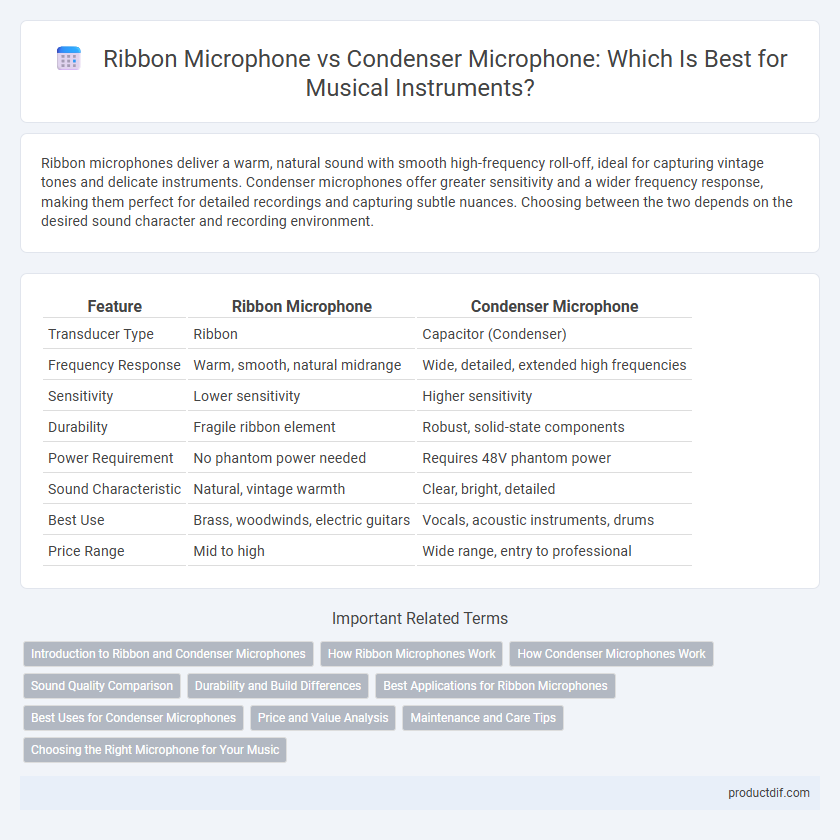Ribbon microphones deliver a warm, natural sound with smooth high-frequency roll-off, ideal for capturing vintage tones and delicate instruments. Condenser microphones offer greater sensitivity and a wider frequency response, making them perfect for detailed recordings and capturing subtle nuances. Choosing between the two depends on the desired sound character and recording environment.
Table of Comparison
| Feature | Ribbon Microphone | Condenser Microphone |
|---|---|---|
| Transducer Type | Ribbon | Capacitor (Condenser) |
| Frequency Response | Warm, smooth, natural midrange | Wide, detailed, extended high frequencies |
| Sensitivity | Lower sensitivity | Higher sensitivity |
| Durability | Fragile ribbon element | Robust, solid-state components |
| Power Requirement | No phantom power needed | Requires 48V phantom power |
| Sound Characteristic | Natural, vintage warmth | Clear, bright, detailed |
| Best Use | Brass, woodwinds, electric guitars | Vocals, acoustic instruments, drums |
| Price Range | Mid to high | Wide range, entry to professional |
Introduction to Ribbon and Condenser Microphones
Ribbon microphones utilize a thin aluminum ribbon suspended within a magnetic field to capture sound with natural warmth and smooth high frequencies, making them ideal for recording vocals and instruments with subtle dynamics. Condenser microphones employ a capacitor with a diaphragm that changes capacitance as sound waves strike it, providing a wide frequency response, high sensitivity, and detailed sound reproduction, suitable for studio vocals and acoustic instruments. Both types are essential in professional audio recording, with ribbon mics excelling at vintage tonal characteristics and condensers offering clarity and precision.
How Ribbon Microphones Work
Ribbon microphones operate by using a thin aluminum ribbon suspended within a magnetic field, which vibrates in response to sound waves, generating an electrical signal. These dynamic transducers are highly sensitive to high-frequency sounds and produce a natural, warm audio character prized in studio recordings. Unlike condenser microphones that rely on a charged diaphragm and backplate, ribbon microphones do not require external power, making them ideal for capturing detailed, vintage-style soundscapes.
How Condenser Microphones Work
Condenser microphones operate using a capacitor with two plates: a fixed backplate and a movable diaphragm that vibrates in response to sound waves, causing variations in capacitance. These variations are converted into electrical signals with the help of an external power source, such as phantom power, enabling high-fidelity sound capture. This technology allows condenser microphones to deliver fast transient response and superior frequency range, making them ideal for recording detailed musical instrument performances.
Sound Quality Comparison
Ribbon microphones produce a warm, natural sound with smooth high frequencies, making them ideal for capturing vintage tones and detailed midrange textures. Condenser microphones offer a wider frequency response and higher sensitivity, delivering crisp, clear, and bright sound suited for vocals and instruments requiring accuracy. Sound quality choice depends on the desired tonal character, with ribbons excelling in smoothness and condensers favoring clarity and detail.
Durability and Build Differences
Ribbon microphones feature a delicate aluminum ribbon element suspended between magnets, making them more fragile and sensitive to physical shocks and high SPLs, whereas condenser microphones utilize a sturdy diaphragm and backplate assembly with robust internal electronics, offering greater durability and resilience in various recording environments. The build of ribbon mics often incorporates a lightweight frame to preserve sensitivity, but this can compromise their resistance to rough handling, while condenser mics typically have metal or reinforced housings that enhance longevity. Engineers prefer condenser microphones for demanding studio or live settings due to their solid construction and higher tolerance to moisture, temperature changes, and physical stress compared to the fragile ribbon counterparts.
Best Applications for Ribbon Microphones
Ribbon microphones excel in capturing warm, natural sound with smooth high-frequency roll-off, making them ideal for recording brass instruments, guitar amps, and vintage vocal performances. Their delicate diaphragm design provides a unique, rich tonal character often sought after in studio settings where subtle nuances and warmth are essential. Ribbon mics perform best in controlled environments, avoiding loud sound pressure levels to maintain clarity and prevent damage.
Best Uses for Condenser Microphones
Condenser microphones excel in capturing detailed and accurate sound, making them ideal for studio recording of vocals, acoustic instruments, and orchestral performances. Their sensitivity and wide frequency response allow for precise reproduction of subtle nuances, which is essential in professional audio production and broadcasting. Best uses include voiceovers, podcasting, and capturing the natural tones of pianos, strings, and percussion instruments.
Price and Value Analysis
Ribbon microphones generally come at a higher price point due to their delicate construction and vintage sound quality, making them a premium choice for studio professionals. Condenser microphones offer a broader price range from affordable entry-level to high-end models, providing versatile value for both beginners and experts. When evaluating price versus performance, condenser microphones deliver more cost-effective options, while ribbon microphones cater to niche markets seeking unique tonal characteristics despite their higher cost.
Maintenance and Care Tips
Ribbon microphones require gentle handling due to their delicate aluminum ribbons, avoiding high sound pressure levels and frequent exposure to moisture to maintain optimal performance. Condenser microphones need regular cleaning of the diaphragm and careful storage to protect the sensitive electronic components and prevent dust accumulation. Both types benefit from using protective cases and controlled environments to extend lifespan and preserve sound quality.
Choosing the Right Microphone for Your Music
Ribbon microphones offer a warm, natural sound ideal for capturing vintage or mellow tones in musical instruments, while condenser microphones provide greater sensitivity and a broader frequency response, making them suitable for detailed and dynamic recordings. Selecting the right microphone depends on the instrument type, recording environment, and desired tonal characteristics, with ribbon mics excelling on brass and guitar amps and condensers favored for vocals, pianos, and acoustic instruments. Understanding these differences enhances clarity and authenticity in music production.
Ribbon Microphone vs Condenser Microphone Infographic

 productdif.com
productdif.com